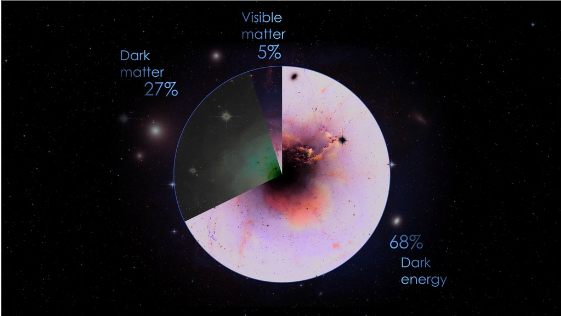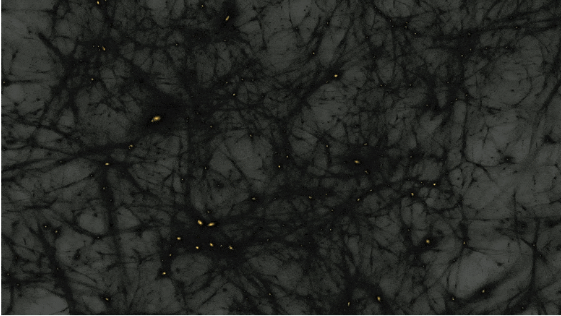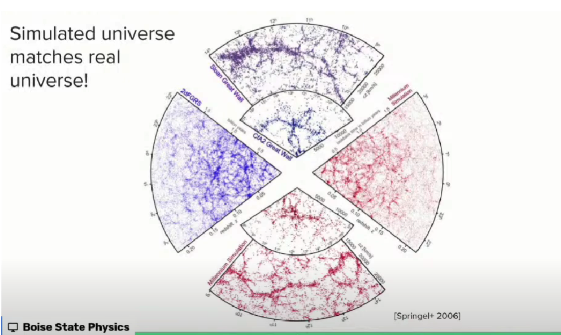What is Dark Matter?
In recent years, the term “Dark Matter” has been brought up significantly about the Cosmos. While many have heard this word, some might not know what this means or what it actually is. Surprisingly, many physicists are also at a loss for the question “What is Dark Matter?” However, there are other aspects of dark matter that we do know and methods that are being used to try and answer that important question. Dr. Yao-Yuan Mao’s research is heavily focused on that big question and while visiting Boise State, went into depth on its place in our universe and what astrophysicists are doing to try to find it.
At the beginning of their talk, Dr. Yao-Yuan Mao describes some of the interesting qualities and relationships of dark matter. Dark matter is a term that refers to unknown, invisible matter that doesn’t absorb or emit light. Furthermore, it does not interact with any known ordinary matter or forces other than gravity. The theory of dark matter was born due to the disparity between observed and measured mass and velocity of galaxies. When galaxies were measured for mass and velocity, the value predicted from these measurements was much less than what was being observed. Which means that these galaxies are heavier and faster than they should be.
This results in a puzzling dilemma. Either the formula that is used to determine a galaxy’s mass and velocity formula which has been tested for centuries and proven accurate countless times is suddenly incorrect. Or there is invisible matter enveloping these galaxies causing them to be faster and more massive than what is measured compared to what is observed. The latter theory is the most plausible.
This theory jumpstarted a new wave of research and discovery on the elusive subject of dark matter. So now the question is have we found dark matter yet? Unfortunately, the answer is no; so you might wonder, how do we determine what it is if it’s something that is invisible and only interacts with gravity? Well, there are a few methods that are being utilized to try and determine what exactly dark matter is.
The first of three is known as direct detection.
This means putting a detector deeply under the surface. Most normal particles can’t get that deep underground, however dark matter, on the other hand, doesn’t interact with ordinary matter so it passes through the surface and will hopefully have a tiny interaction with something while in the detector. The second method is indirection detection. This revolves around the idea that dark matter might not interact with normal matter but with themselves. If they do collide these particles could annihilate each other and create gamma ray photons. We have gamma-ray telescopes in space looking at areas with a high density of dark matter and looking for a signal. The final method is the collider production method. Instead of waiting for a signal through the indirection method, instead, we can smash ordinary particles together at the Large Hadron Collider in Geneva and see if we can produce a dark matter particle by smashing ordinary particles together.
While we have not been able to determine what exactly makes up dark matter, we can however still study it through a few methods. One way to study the amount of dark matter is through the Cosmic Microwave Background. Dr. Yao-Yuan Mao states: “The amount of fluctuation in the Cosmic Microwave Background tells you how much expansion and pulling the two opposite forces between dark matter and dark energy there is. By studying this particular pattern of the very early universe, we can make a very precise prediction about the expected amount of dark matter and dark energy.” This is how we can determine the ratio of matter in the universe which is that the universe is 25-30% dark matter, 65-70% dark energy, and about 5% normal matter.

From information like this, we can create theories of how dark matter interacts with our universe, specifically how it interacts with galaxy formation. Dr. Yao-Yuan Mao describes a theory, stating: “We start with a homogeneous universe and then dark matter starts to pull at each other and form potential wells, those then pull in hydrogen gas, ordinary matter, until the density is high enough to begin the formation of a star, then the formation of a galaxy, and then those galaxies merge and they form larger and larger galaxies. Hence the title of this talk: Dark Matter: The Invisible Nest of Galaxies.”

Furthermore, astrophysicists believe that larger galaxies will live in larger halos and smaller galaxies live in smaller halos, halos referring to dense areas of dark matter in our universe. With this theory, you can create a theoretical dark matter, base map of the universe. To prove that this web of dark matter exists we can take our theory of where these dark matter regions lie, and plot different-sized galaxies in those different-sized high-density points. When comparing this plot with the real universe, it is strikingly similar. This shows strong evidence for a galaxy-halo connection just through the assumption that larger galaxies live in large halos and small galaxies live in small halos.

Dr. Yao-Yuan Mao’s research is finding Milky Way-type galaxies create a statistical statement about how unique the Milky Way is and its relationship with dark matter; similar to the statistical statement created from the relationship between galaxy’s sizes and their halos.
To get a better understanding of dark matter and Dr. Yao-Yuan Mao’s research, you can visit their website at: Yao-Yuan Mao website
To watch the recording of their First Friday presentation visit: First Friday Astronomy – October 2023 – Dr. Yao-Yuan Mao – Dark Matter: Invisible Nests of Galaxies